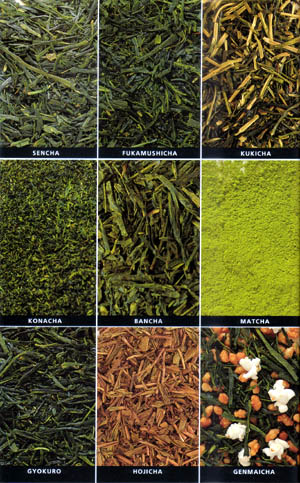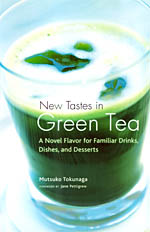Green tea

There are about twenty different types of Japanese tea. The kind most often made in Japan is the steamed type of sencha and fukamushicha, which together account for seventy-five percent of the tea produced in the country. Aromatic teas such as bancha and hojicha are very popular as well.
Tea is grown throughout Japan, but the areas that are most well known for their tea are Shizuoka, Kagoshima, and Uji, all of which have types of tea named after them. Many other locales also have their own distinctive local teas with their devoted enthusiasts.
A tea drinker may sometimes want an astringent taste and at other times desires a smooth, aromatic blend. This book sets out to familiarize tea drinkers with the range of possibilities, presenting enough information about the kinds of teas out there and the kind of taste each has, so that the best tea can be selected for the mood or occasion. The world of tea is vast but easily navigated with a little knowledge and a willingness to experiment.
Sencha

The flavors that distinguish sencha are a delicate sweetness and a mild astringency. Sencha refers to the first picking of the tea bush, which takes place from late February in warm climates to the end of May in cooler areas. The tea leaves of later pickings, which have more astringency, constitute the tea known as bancha. The glossy leaves of the tea bush are nearly uniform in size and impart a refreshing fragrance. Sencha is high in vitamin C and is especially popular with women as a teatime drink.
A new variety of sencha (mizudashi-sencha) specially prepared for steeping in cold water is now available on the market and enjoys brisk sales in summer. Powdered sencha (funmatsucha) is another product on the market, although it is easily made by grinding sencha leaves in a coffee mill or a food processor. It is excellent for adding to drinks and cooked dishes.
Fukamushicha

The processing of fukamushicha is the same as for sencha, except that for fukamushicha the leaves are steamed two or three times longer. As a result, the leaves become withered, and the color is also darker. However, the taste remains just as "sweet" and moderate, and the fragrance is richer and deeper. Despite the stronger aroma, fukamushicha is gentle on the stomach, and you can drink as many cups as you wish.
Kukicha

Kukicha consists of stems and stalks normally discarded in the production of sencha, gyokuro, and matcha teas. kukicha produced from the stalks of gyokuro is known as "karigane" and is highly prized. Kukicha made from either gyokuro or sencha is served in the same way as its base tea. The clean taste and light fragrance are sure to help you wake up feeling refreshed.
Konacha

Konacha (or "tea powder") is the tea served at sushi restaurants, where it is called "agari." It consists of the rejected buds and tea "dust" left over from the processing of sencha and gyokuro. It is reasonably priced and has a strong color, flavor, and aroma, making it an ideal cooking ingredient.
Bancha

After the first picking for sencha is done from late February to the end of May, new shoots and leaf buds begin to grow, and these are used for bancha. Bancha leaves are picked in June (nibancha), August (sanbancha), and October (yonbancha), with the leaves becoming tougher with each subsequent picking. As well as the leaves, bancha includes the upper stems and some larger leaves discarded during the process of sencha production.
Compared to sencha, bancha is more astringent and less fragrant, making it just the right tea to sip after a heavy meal. As it contains more fluoride than other teas, it is effective against tooth decay and halitosis. High-grade bancha with less astringency and a pleasant fragrance is known as "senryu." Those tea leaves are also longer and thinner.
Matcha

Matcha is the powdered tea used in Japan's formal tea ceremony. In its unpowdered form it is called "tencha." Top-grade matcha is a bright shade of green. As a rule, the lighter green varieties are sweeter and the darker ones more astringent. When the new shoots on the tea bush have two or three leaves, they are shaded from sunlight with straw, reed, or cloth screens for two or three weeks.
In the processing of tencha, the leaves are dried after being steamed but are not rolled, unlike most other green teas. During the drying process all the leaf veins and fine stems are removed before the leaves are ground into a fine powder in a mill. As with powdered sencha, matcha completely dissolves in the water when well mixed and thus the leaf is consumed in its entirety, providing more nutrients. Matcha is a popular ingredient in savory dishes as well as desserts.
Gyokuro

Rich green gyokuro is a top-grade tea. It owes its sweet, mild flavor to high levels of theanine, an amino acid generated by covering the tea bushes with a reed screen two to three weeks prior to picking. This shields the leaves from direct sunlight and results in leaves that are dark green when dried. It is processed in the same way as tencha (see matcha). Gyokuro contains a lot of caffeine and chlorophyl. Caffeine stimulates the brain and the nervous system, while chlorophyl stimulates tissue growth, resulting in healthy skin.
Hojicha

Hojicha is produced by roasting bancha or sencha over a high heat, resulting in brownish leaves imbued with a savory fragrance. Since it contains relatively little caffeine and tannin, it is good for children, older people, and those recovering from illness. It can also be served cold in the summer.
Genmaicha

Bancha or medium-grade sencha combined with well-roasted and popped brown rice (genmai) is known as genmaicha. The rice adds a slightly nutty taste, and its mild flavor makes it the ideal tea to drink after a meal that includes oily or deep-fried foods, such as tempura or Chinese cuisine.
Source Notes

Reprinted with permission from the book:
New Tastes in Green Tea
Kodansha International
New Tastes in Green Tea is an original cookbook that ushers an underappreciated flavor into the kitchen as a beverage and a cooking ingredient. The range of recipes is startling. Green Tea Latte, Matcha Smoothie, or Iced Matcha au Lait take "the greens" in new directions. Mouthwatering recipes for gratin, quiche, pastas, and desserts will enliven the adventurous cook's culinary repertoire
Whether you are looking for a bevy of palate-pleasing drinks or savory new food recipes, New Tastes in Green Tea is a must-have for anyone seeking to appreciate the versatility and elegant flavorings of one of the world's most healthful beverages.
ISBN4-7700-2986-1
Y2625
- Order this book from amazon.com
- Order this book from amazon.co.jp (in Japan)
- Find this book at your local English-language bookstore in Japan
- Or use the ISBN to order from your local bookstore.
More articles
- © Copyright Lobster Enterprises
- Privacy
- Bento.com top
- © Copyright Lobster Enterprises
- Privacy
- Bento.com top
- © Copyright Lobster Enterprises
- Privacy
- Bento.com top







